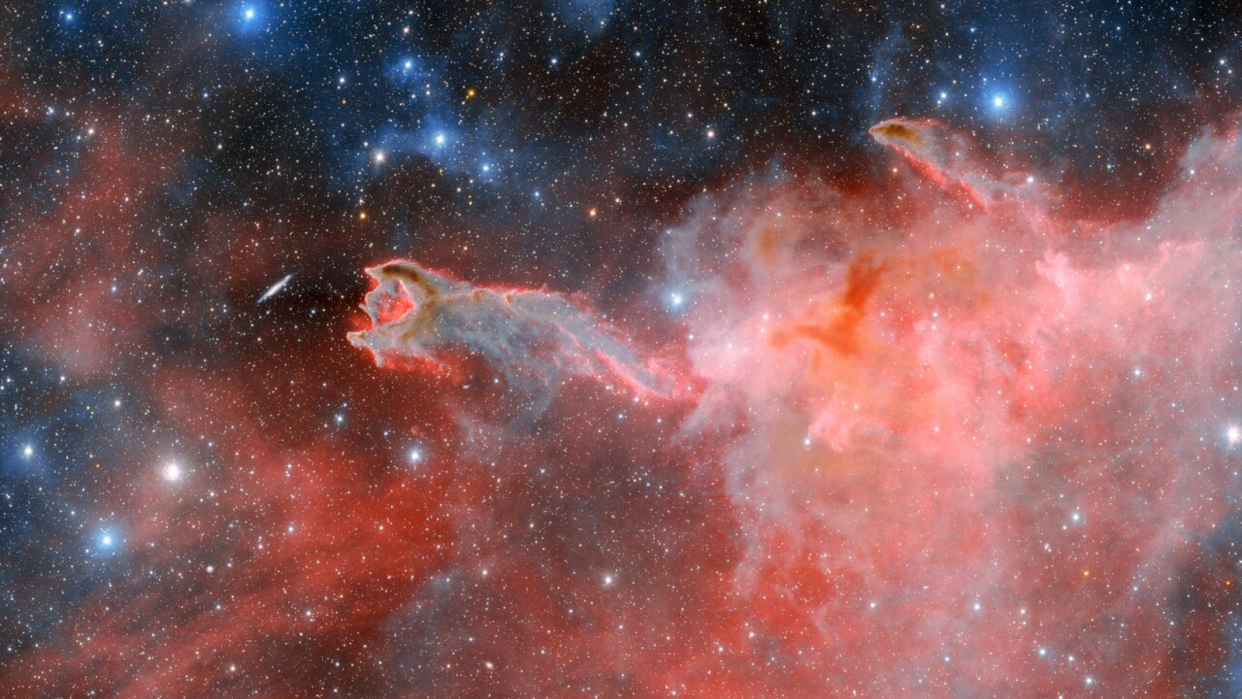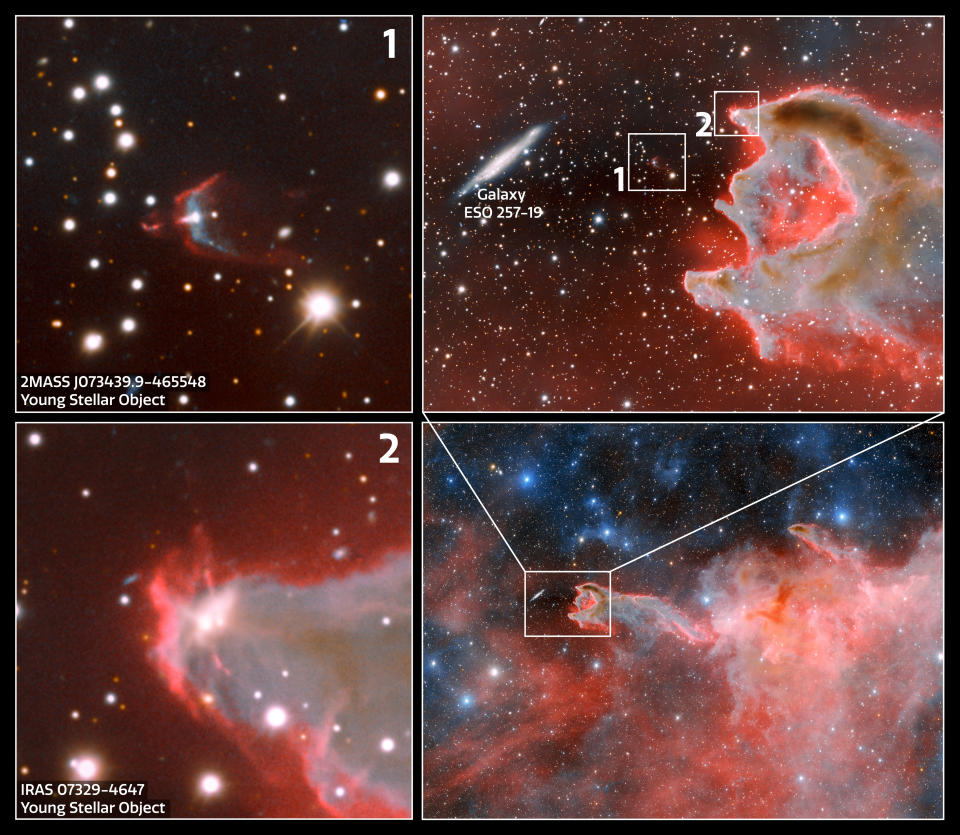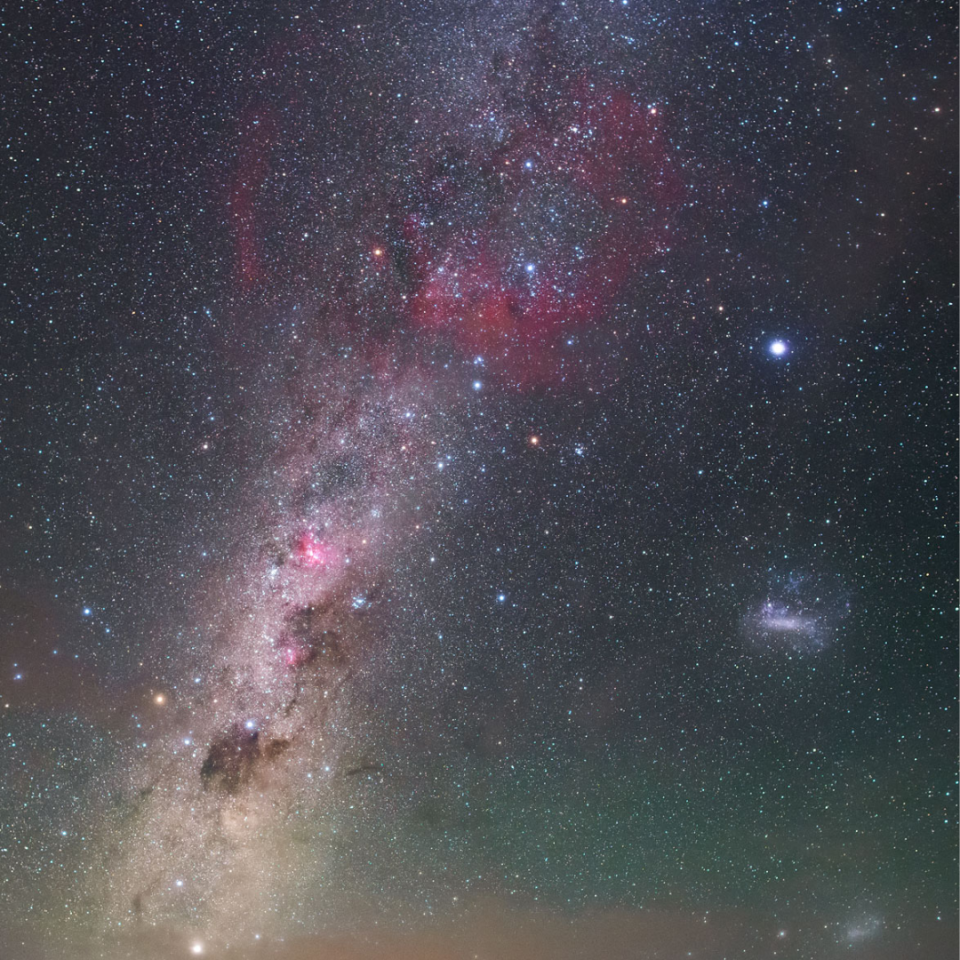'God's Hand' interstellar cloud reaches for the stars in new Dark Energy Camera image (video)

The Dark Energy Camera (DECam) has captured an ominous and ghostly hand reaching from the Milky Way from a distant edge-on spiral galaxy. But don't panic; despite its nickname, "God's Hand," there is nothing supernatural about this structure — yet that doesn't make it any less awe-inspiring.
God's Hand is actually a cometary globule officially known as CG 4. It is located around 1,300 light-years from Earth within our Milky Way galaxy and seen in the constellation Puppis. Cometary globules are a hard-to-detect subclass of so-called Bok globules, which are isolated and dense clouds of gas and dust surrounded by hot, ionized material.
Despite their name, cometary globules have nothing to do with comets. The moniker actually comes from the fact that these nebulas have had material dragged away from them, creating a long tail that resembles the characteristic tail of a comet.
Related: Dark Energy Camera captures record-breaking image of a dead star's scattered remains

Cometary globules remain somewhat mysterious because the cause of their structure hasn't yet been definitively determined. Scientists hypothesize that the structure of cometary globules could be created by stellar winds that flow from the hot, massive stars surrounding them, or from the supernovas that occur when these stars die.
Reach for the skies!
CG 4's distinctive tail, which helps define it as a cometary nebula, is an 8 light-year-long faint tendril of gas and dust with a 1.5 light-year-wide tip. This feature is stunningly apparent in the images from the DECam, an instrument located on the Victor M. Blanco 4-meter Telescope at the Cerro Tololo Inter-American Observatory, which is located at an altitude of 7,200 feet (2,200 meters) above Chile. Images like this one may finally help crack the mystery of cometary globule and Bok nebula creation.
Bok clusters weren't discovered by astronomers until the mid-1970s, evading detection for so long because of how faint they are and the fact that their tails are shrouded by stellar dust that prevents light from passing through it.
To see through this dust, the DECam is outfitted with a Hydrogen-alpha filter that allows it to image ionized hydrogen. In the image of the God's hand globule, this matter is seen as a red glow within CG 4, its "claw," and outlining its edge. Ionized hydrogen and its glow is created when this element is bombarded by intense radiation from nearby mass stars, stripping away electrons or "ionizing" the gas.

The lobster-claw-like head of CG 4 appears in the image to be reaching out for the spiral galaxy ESO 257-19 (PGC 21338), which is seen edge-on from our perspective on Earth. Though the galaxy may appear about to be gripped by God's Hand or a cosmic lobster claw, it is safe from harm, located around 100 million light-years from CG 4.
Even if ESO 257-19 were closer to CG 4 (and not an entire galaxy and thus vastly bigger than CG 4), it would be safe from the grasp of this celestial God's Hand, because the same radiation that is ionizing the 'Hand's' hydrogen is also disintegrating its structure. Despite this, there is still enough gas and dust within CG 4 to form several new sun-sized stars.
Bok nebula are found throughout our galaxy, but the majority of them, like CG 4 and 30 others, are located within the Gum Nebula, also known as "Gum 12." This is a huge cloud of gas around 1,400 light-years away that is spread across the constellations Puppis and Vela. Gum 12 is thought to be the expanding remnants of a massive star that died in a supernova explosion around a million years ago.

Related Stories:
— Pulsar surprises astronomers with record-breaking gamma-rays
— 3.3 billion Milky Way objects revealed by colossal astronomical survey
— Dark Energy Camera peels back layers of 'galactic onion' stretched across space
Scientists suggest two mechanisms that could create a cometary globule such as CG 4. One of these occurs when stellar winds and radiation from massive stars 'sculpt' gas and dust into a comet-like shape; the other is that they could be spherical nebulas that may have been disrupted by a nearby supernova explosion.
The tails of the cometary globules within Gum 12 appear to be pointing away from the Vela supernova and the rapidly spinning neutron star pulsar at the heart of this nebula. The star that collapsed to create this pulsar must have been massive, and thus, it could have been its stellar winds before its death that sculpted the cometary nebula of Gum 12.

